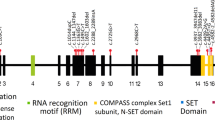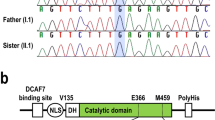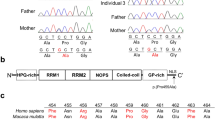Abstract
Background
Haploinsufficiency of the human nuclear receptor binding suppressor of variegation 3–9, enhancer of zeste, and trithorax (SET) domain 1 (NSD1) gene causes a developmental disorder called Sotos syndrome 1 (SOTOS1), which is associated with overgrowth and macrocephaly. NSD family proteins encoding histone H3 lysine 36 (H3K36) methyltransferases are conserved in many species, and Drosophila has a single NSD homolog gene, NSD.
Objective
To gain insight into the biological functions of NSD1 deficiency in the developmental anomalies seen in SOTOS1 patients using an NSD-deleted Drosophila mutant.
Methods
We deleted Drosophila NSD using CRISPR/Cas9-mediated targeted gene knock-out, and analyzed pleiotropic phenotypes of the homozygous mutant of NSD (NSD−/−) at various developmental stages to understand the roles of NSD in Drosophila.
Results
The site-specific NSD deletion was confirmed in the mutant. The H3K36 di-methylation levels were dramatically decreased in the NSD−/− fly. Compared with the control, the NSD−/− fly displayed an increase in the body size of larvae, similar to the childhood overgrowth phenotype of SOTOS1 patients. Although the NSD mutant flies survived to adulthood, their fecundity was dramatically decreased. Furthermore, the NSD−/− fly showed neurological dysfunctions, such as lower memory performance and motor defects, and a diminished extracellular signal-regulated kinase (ERK) activity.
Conclusions
The NSD-deleted Drosophila phenotype resembles many of the phenotypes of SOTOS1 patients, such as learning disability, deregulated ERK signaling, and overgrowth; thus, this mutant fly is a relevant model organism to study various SOTOS1 phenotypes.




Similar content being viewed by others
References
Battaglia A, Filippi T, Carey JC (2008) Update on the clinical features and natural history of Wolf-Hirschhorn (4p–) syndrome: experience with 87 patients and recommendations for routine health supervision. Am J Med Genet 148C:246–251. https://doi.org/10.1002/ajmg.c.30187
Bell O, Wirbelauer C, Hild M et al (2007) Localized H3K36 methylation states define histone H4K16 acetylation during transcriptional elongation in Drosophila. EMBO J 26:4974–4984. https://doi.org/10.1038/sj.emboj.7601926
Bender LB, Suh J, Caroll CR et al (2006) MES-4: an autosome-associated histone methyltransferase that participates in silencing the X chromosomes in the C. elegans germ line. Development 133:3907–3917. https://doi.org/10.1242/dev.02584
Cabianca DS, Muñoz-Jiménez C, Kalck V et al (2019) Active chromatin marks drive spatial sequestration of heterochromatin in C. elegans nuclei. Nature 569:734–739. https://doi.org/10.1038/s41586-019-1243-y
Capowski EE, Martin P, Garvin C, Strome S (1991) Identification of grandchildless loci whose products are required for normal germ-line development in the nematode Caenorhabditis elegans. Genetics 129:1061–1072
Cichewicz K, Hirsh J (2018) ShinyR-DAM: a program analyzing Drosophila activity, sleep and circadian rhythms. Commun Biol 1:25. https://doi.org/10.1038/s42003-018-0031-9
Cole TR, Hughes HE (1994) Sotos syndrome: a study of the diagnostic criteria and natural history. J Med Genet 31:20–32. https://doi.org/10.1136/jmg.31.1.20
Dikow N, Maas B, Gaspar H et al (2013) The phenotypic spectrum of duplication 5q35.2–q35.3 encompassing NSD1: is it really a reversed Sotos syndrome? Am J Med Genet 161A:2158–2166. https://doi.org/10.1002/ajmg.a.36046
Douglas J, Hanks S, Temple IK et al (2003) NSD1 mutations are the major cause of Sotos syndrome and occur in some cases of Weaver syndrome but are rare in other overgrowth phenotypes. Am J Hum Genet 72:132–143. https://doi.org/10.1086/345647
Fickie MR, Lapunzina P, Gentile JK et al (2011) Adults with Sotos syndrome: review of 21 adults with molecularly confirmed NSD1 alterations, including a detailed case report of the oldest person. Am J Med Genet 155A:2105–2111. https://doi.org/10.1002/ajmg.a.34156
Foster A, Zachariou A, Loveday C et al (2019) The phenotype of Sotos syndrome in adulthood: a review of 44 individuals. Am J Med Genet 181:502–508. https://doi.org/10.1002/ajmg.c.31738
Franco LM, de Ravel T, Graham BH et al (2010) A syndrome of short stature, microcephaly and speech delay is associated with duplications reciprocal to the common Sotos syndrome deletion. Eur J Hum Genet 18:258–261. https://doi.org/10.1038/ejhg.2009.164
Gratz SJ, Cummings AM, Nguyen JN et al (2013) Genome engineering of Drosophila with the CRISPR RNA-guided Cas9 nuclease. Genetics 194:1029–1035. https://doi.org/10.1534/genetics.113.152710
Jantrapirom S, Lo Piccolo L, Yoshida H, Yamaguchi M (2018) A new Drosophila model of Ubiquilin knockdown shows the effect of impaired proteostasis on locomotive and learning abilities. Exp Cell Res 362:461–471. https://doi.org/10.1016/j.yexcr.2017.12.010
Jeong Y, Kim T, Kim S et al (2018) Overexpression of histone methyltransferase NSD in Drosophila induces apoptotic cell death via the Jun-N-terminal kinase pathway. Biochem Biophys Res Commun 496:1134–1140. https://doi.org/10.1016/j.bbrc.2018.01.156
Kahsai L, Zars T (2011) Learning and memory in Drosophila: behavior, genetics, and neural systems. Int Rev Neurobiol 99:139–167. https://doi.org/10.1016/B978-0-12-387003-2.00006-9
Kamal NM, Althobiti JM, Alsaedi A et al (2018) Sotos syndrome: a case report of 1st genetically proven case from Saudi Arabia with a novel mutation in NSD1 gene. Medicine (Baltim) 97:e12867. https://doi.org/10.1097/MD.0000000000012867
Kim T, Shin H, Song B et al (2020) Overexpression of H3K36 methyltransferase NSD in glial cells affects brain development in Drosophila. Glia 68:2503–2516. https://doi.org/10.1002/glia.23867
Kurotaki N, Imaizumi K, Harada N et al (2002) Haploinsufficiency of NSD1 causes Sotos syndrome. Nat Genet 30:365–366. https://doi.org/10.1038/ng863
Larkin A, Marygold SJ, Antonazzo G et al (2021) FlyBase: updates to the Drosophila melanogaster knowledge base. Nucleic Acids Res 49:D899–D907. https://doi.org/10.1093/nar/gkaa1026
Lucio-Eterovic AK, Singh MM, Gardner JE et al (2010) Role for the nuclear receptor-binding SET domain protein 1 (NSD1) methyltransferase in coordinating lysine 36 methylation at histone 3 with RNA polymerase II function. Proc Natl Acad Sci USA 107:16952–16957. https://doi.org/10.1073/pnas.1002653107
Luscan A, Laurendeau I, Malan V et al (2014) Mutations in SETD2 cause a novel overgrowth condition. J Med Genet 51:512–517. https://doi.org/10.1136/jmedgenet-2014-102402
Martin-Herranz DE, Aref-Eshghi E, Bonder MJ et al (2019) Screening for genes that accelerate the epigenetic aging clock in humans reveals a role for the H3K36 methyltransferase NSD1. Genome Biol 20:146. https://doi.org/10.1186/s13059-019-1753-9
Matthews BB, Dos Santos G, Crosby MA et al (2015) Gene Model Annotations for Drosophila melanogaster: impact of high-throughput data. G3 5:1721–1736. https://doi.org/10.1534/g3.115.018929
McClelland J, Burgess B, Crock P, Goel H (2016) Sotos syndrome: an unusual presentation with intrauterine growth restriction, generalized lymphedema, and intention tremor. Am J Med Genet 170A:1064–1069. https://doi.org/10.1002/ajmg.a.37535
McDaniel SL, Hepperla AJ, Huang J et al (2017) H3K36 methylation regulates nutrient stress response in Saccharomyces cerevisiae by enforcing transcriptional fidelity. Cell Rep 19:2371–2382. https://doi.org/10.1016/j.celrep.2017.05.057
Migdalska AM, van der Weyden L, Ismail O et al (2012) Generation of the Sotos syndrome deletion in mice. Mamm Genome 23:749–757. https://doi.org/10.1007/s00335-012-9416-0
Oishi S, Zalucki O, Vega MS et al (2020) Investigating cortical features of Sotos syndrome using mice heterozygous for Nsd1. Genes Brain Behav 19:e12637. https://doi.org/10.1111/gbb.12637
Park SH, Lee JE, Sohn YB, Ko JM (2014) First identified Korean family with Sotos syndrome caused by a novel intragenic mutation in NSD1. Ann Clin Lab Sci 44:228–231
Rayasam GV, Wendling O, Angrand P-O et al (2003) NSD1 is essential for early post-implantation development and has a catalytically active SET domain. EMBO J 22:3153–3163. https://doi.org/10.1093/emboj/cdg288
Rechtsteiner A, Ercan S, Takasaki T et al (2010) The histone H3K36 methyltransferase MES-4 acts epigenetically to transmit the memory of germline gene expression to progeny. PLoS Genet 6:e1001091. https://doi.org/10.1371/journal.pgen.1001091
Righini A, Ciosci R, Selicorni A et al (2007) Brain magnetic resonance imaging in Wolf-Hirschhorn syndrome. Neuropediatrics 38:25–28. https://doi.org/10.1055/s-2007-981685
Rio M, Clech L, Amiel J et al (2003) Spectrum of NSD1 mutations in Sotos and Weaver syndromes. J Med Genet 40:436–440. https://doi.org/10.1136/jmg.40.6.436
Roberts PJ, Der CJ (2007) Targeting the Raf-MEK-ERK mitogen-activated protein kinase cascade for the treatment of cancer. Oncogene 26:3291–3310. https://doi.org/10.1038/sj.onc.1210422
Rosenfeld JA, Kim KH, Angle B et al (2013) Further evidence of contrasting phenotypes caused by reciprocal deletions and duplications: duplication of NSD1 causes growth retardation and microcephaly. Mol Syndromol 3:247–254. https://doi.org/10.1159/000345578
Sohn YB, Lee CG, Ko JM et al (2013) Clinical and genetic spectrum of 18 unrelated Korean patients with Sotos syndrome: frequent 5q35 microdeletion and identification of four novel NSD1 mutations. J Hum Genet 58:73–77. https://doi.org/10.1038/jhg.2012.135
Sotos JF, Dodge PR, Muirhead D et al (1964) Cerebral gigantism in childhood. A syndrome of excessively rapid growth and acromegalic features and a nonprogressive neurologic disorder. N Engl J Med 271:109–116. https://doi.org/10.1056/NEJM196407162710301
Suzuki S, Kato H, Suzuki Y et al (2016) Histone H3K36 trimethylation is essential for multiple silencing mechanisms in fission yeast. Nucleic Acids Res 44:4147–4162. https://doi.org/10.1093/nar/gkw008
Tatton-Brown K, Douglas J, Coleman K et al (2005) Genotype-phenotype associations in Sotos syndrome: an analysis of 266 individuals with NSD1 aberrations. Am J Hum Genet 77:193–204. https://doi.org/10.1086/432082
Tatton-Brown K, Rahman N (2007) Sotos syndrome. Eur J Hum Genet 15:264–271. https://doi.org/10.1038/sj.ejhg.5201686
Türkmen S, Gillessen-Kaesbach G, Meinecke P et al (2003) Mutations in NSD1 are responsible for Sotos syndrome, but are not a frequent finding in other overgrowth phenotypes. Eur J Hum Genet 11:858–865. https://doi.org/10.1038/sj.ejhg.5201050
Venkatesh S, Smolle M, Li H et al (2012) Set2 methylation of histone H3 lysine 36 suppresses histone exchange on transcribed genes. Nature 489:452–455. https://doi.org/10.1038/nature11326
Visser R, Landman EBM, Goeman J et al (2012) Sotos syndrome is associated with deregulation of the MAPK/ERK-signaling pathway. PLoS One 7:1–9. https://doi.org/10.1371/journal.pone.0049229
Waggoner DJ, Raca G, Welch K et al (2005) NSD1 analysis for Sotos syndrome: insights and perspectives from the clinical laboratory. Genet Med 7:524–533. https://doi.org/10.1097/01.GIM.0000178503.15559.d3
Wagner EJ, Carpenter PB (2012) Understanding the language of Lys36 methylation at histone H3. Nat Rev Mol Cell Biol 13:115–126. https://doi.org/10.1038/nrm3274
Wang GG, Cai L, Pasillas MP, Kamps MP (2007) NUP98-NSD1 links H3K36 methylation to Hox-A gene activation and leukaemogenesis. Nat Cell Biol 9:804–812
Weinberg DN, Papillon-Cavanagh S, Chen H et al (2019) The histone mark H3K36me2 recruits DNMT3A and shapes the intergenic DNA methylation landscape. Nature 573:281–286. https://doi.org/10.1038/s41586-019-1534-3
Wellbrock C, Ogilvie L, Hedley D et al (2004) V599EB-RAF is an oncogene in melanocytes. Cancer Res 64:2338–2342. https://doi.org/10.1158/0008-5472.can-03-3433
Zhang H, Lu X, Beasley J et al (2011) Reversed clinical phenotype due to a microduplication of Sotos syndrome region detected by array CGH: microcephaly, developmental delay and delayed bone age. Am J Med Genet 155A:1374–1378. https://doi.org/10.1002/ajmg.a.33769
Zhang S, Zhang F, Chen Q et al (2019) CRISPR/Cas9-mediated knockout of NSD1 suppresses the hepatocellular carcinoma development via the NSD1/H3/Wnt10b signaling pathway. J Exp Clin cancer Res 38:467. https://doi.org/10.1186/s13046-019-1462-y
Zhuang L, Jang Y, Park Y-K et al (2018) Depletion of Nsd2-mediated histone H3K36 methylation impairs adipose tissue development and function. Nat Commun 9:1796. https://doi.org/10.1038/s41467-018-04127-6
Acknowledgements
This research was supported by Science Research Programs of the National Research Foundation (NRF) of Korea (NRF-2018R1D1A1B07050206 to I.-S. L.) and Konkuk University’s research support program (I.-S. L. and T. Kim) in 2020.
Author information
Authors and Affiliations
Corresponding author
Ethics declarations
Conflict of interest
The authors have no financial and competing interests to declare.
Additional information
Publisher’s Note
Springer Nature remains neutral with regard to jurisdictional claims in published maps and institutional affiliations.
Supplementary Information
Below is the link to the electronic supplementary material.
Rights and permissions
About this article
Cite this article
Choi, S., Song, B., Shin, H. et al. Drosophila NSD deletion induces developmental anomalies similar to those seen in Sotos syndrome 1 patients. Genes Genom 43, 737–748 (2021). https://doi.org/10.1007/s13258-021-01091-2
Received:
Accepted:
Published:
Issue Date:
DOI: https://doi.org/10.1007/s13258-021-01091-2




